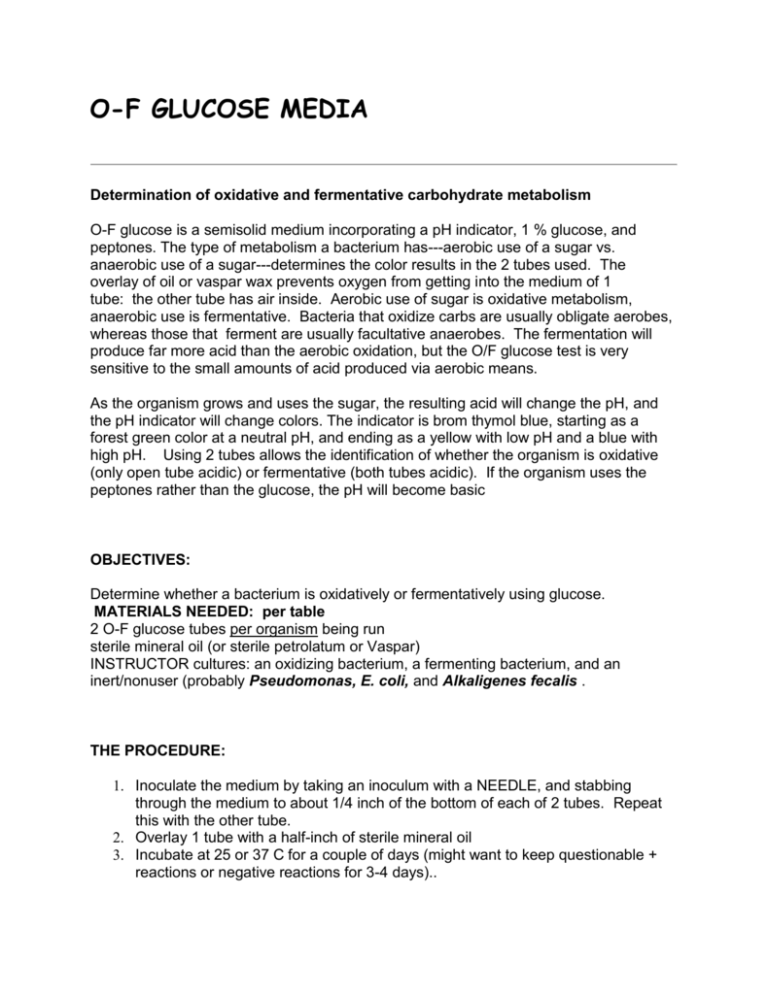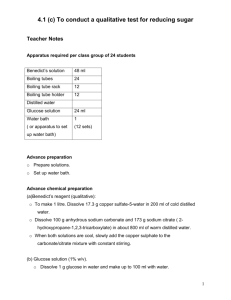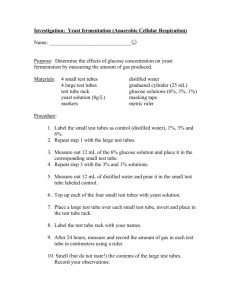O-F glucose
advertisement

O-F GLUCOSE MEDIA Determination of oxidative and fermentative carbohydrate metabolism O-F glucose is a semisolid medium incorporating a pH indicator, 1 % glucose, and peptones. The type of metabolism a bacterium has---aerobic use of a sugar vs. anaerobic use of a sugar---determines the color results in the 2 tubes used. The overlay of oil or vaspar wax prevents oxygen from getting into the medium of 1 tube: the other tube has air inside. Aerobic use of sugar is oxidative metabolism, anaerobic use is fermentative. Bacteria that oxidize carbs are usually obligate aerobes, whereas those that ferment are usually facultative anaerobes. The fermentation will produce far more acid than the aerobic oxidation, but the O/F glucose test is very sensitive to the small amounts of acid produced via aerobic means. As the organism grows and uses the sugar, the resulting acid will change the pH, and the pH indicator will change colors. The indicator is brom thymol blue, starting as a forest green color at a neutral pH, and ending as a yellow with low pH and a blue with high pH. Using 2 tubes allows the identification of whether the organism is oxidative (only open tube acidic) or fermentative (both tubes acidic). If the organism uses the peptones rather than the glucose, the pH will become basic OBJECTIVES: Determine whether a bacterium is oxidatively or fermentatively using glucose. MATERIALS NEEDED: per table 2 O-F glucose tubes per organism being run sterile mineral oil (or sterile petrolatum or Vaspar) INSTRUCTOR cultures: an oxidizing bacterium, a fermenting bacterium, and an inert/nonuser (probably Pseudomonas, E. coli, and Alkaligenes fecalis . THE PROCEDURE: 1. Inoculate the medium by taking an inoculum with a NEEDLE, and stabbing through the medium to about 1/4 inch of the bottom of each of 2 tubes. Repeat this with the other tube. 2. Overlay 1 tube with a half-inch of sterile mineral oil 3. Incubate at 25 or 37 C for a couple of days (might want to keep questionable + reactions or negative reactions for 3-4 days).. YOUR INSTRUCTOR WILL INOCULATE 3 demo bacteria for the entire class: Pseudomonas, E. coli, and Alkaligenes fecalis . INTERPRETATION: If you get a NEGATIVE reaction with no acid in either tube, it may be a good idea to confirm it by running another glucose test using sugar discs or phenol red glucose. However, this is a more sensitive glucose test than phenol red since there is less peptone in the medium (can counteract the acidity of the glucose use) and the bro thymold indicator is more sensitive to small amounts of acidity than phenol red indicator. Those bacteria which use the peptides rather than the sugar will produce basic end products, causing the brom thymol blue to become a blue-green or blue. Although this is a biochemical reaction, it is of no consequence in the reading of this test. REACTION TUBE W/O OIL WITH OIL OVERLAY oxidation Yellow - top tube only No yellow blue or green fermentation entire tube yellow entire tube yellow green inert entire tube entire tube blue or green NEGATIVE QUESTIONS: 1. The pH indicator in this medium is: 2. Why might you get a blue color rather than a yellow color reaction? 3. You are identifying the ability of the microbe to utilize the sugar _____. Fall 2011 - Jackie Reynolds, Richland College, BIOL 2421







